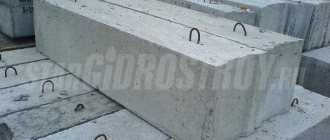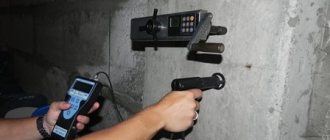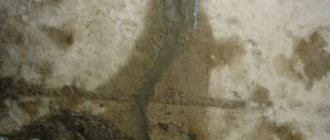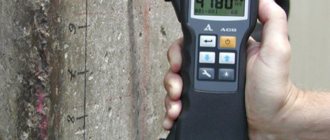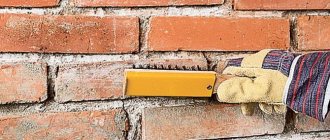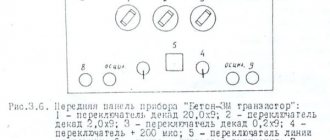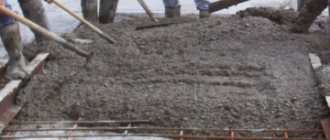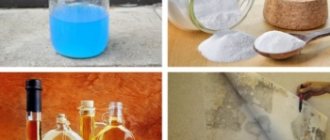The basement is a damp, cool place that doesn’t get enough sunlight or fresh air, which creates favorable conditions for mold to grow. It develops from spores present in the soil. Impossible not to notice mold in the basement. An unpleasant color deposit appears on walls and other surfaces, and a specific damp smell can be heard in the room.
What types of mold are found in the basement?
If you see that there is mold in the basement of a garage or house, do not allow it to spread, otherwise it will cause harm to buildings and people. In basement rooms, black and white mold and blue fungi are most often found.
Black mold
It has several strains, the most common among them:
- Chaetomium - causes allergies; if mold of this type gets into the digestive tract, a person can even die;
- Ulocladium – affects construction and finishing materials and products. Moisture is necessary for its development;
- Alternaria - appears on vegetables and fruits in the basement, negatively affects human health - affects the skin and respiratory tract;
- Cladosporium - besides black, it has other shades and is dangerous for plants and seeds. Can be powered by fuels, lubricants and diesel fuel;
- Aspergillus - this fungus is often found in basements and causes aspergillosis in humans and animals.
White mold
She loves warmth and moisture, the absence of sunlight. The fungus can cause allergies, chronic bronchitis, sinusitis, asthma, and irritate the respiratory tract. White mold, settling on the walls, ceiling and floor, destroys them. It negatively affects the condition of products stored in the basement - they rot and quickly deteriorate.
Blue fungi
In most cases, they affect wood. There are several types of such mold: bacterial, white and brown. If blue mold appears in the basement of a wooden house, beware: its spores develop intensively, and it can quickly “move” into the house.
Preventing the recurrence of mold in the cellar
- Try to monitor the temperature of the cellar: it should not be too high or too low. If the basement is too warm in winter, it is necessary to lower the temperature in it to an acceptable level by opening the ventilation plug or door for a while. Cold air is also not recommended for the normal functioning of the cellar, so care should be taken to heat or insulate it. It can be heated using electric heating devices, and insulated with thermal insulation materials or with snow/straw thrown over the basement hatch.
- It is necessary to provide the basement with good air circulation. It is advisable to ventilate it every day, leaving it open for 15 minutes. You can also drill holes in the door or create free space between the floor and the door. A good solution would be to run a pipe from the floor and from the ceiling for the free flow of oxygen. Often the cause of mold is a vent that is too small or clogged. A solution may be to use an exhaust fan, which is installed directly on the opening in the ventilation. The device improves air circulation, which means it resists increased humidity in the cellar. To prevent condensation from forming on the surfaces of the cellar, you can free up a small space between the wall and the shelves or racks.
- In order for the fungus to recede, it is necessary that the basement remains dry. To do this, you need to provide it with good waterproofing, namely, cover the walls, floor and ceiling with moisture-proof material after you treat them with an antifungal agent. You can then plaster the walls for added protection. Provide for a drainage system in the cellar, roof slopes, blind areas and drainpipes. It is also necessary to seal all cracks and cracks in the walls and floors with cement mortar or putty to avoid moisture from entering from the outside.
Author: Bryantsev Viktor
Not found
Causes of mold in the basement
Fungal spores “take root” on concrete, stone, metal, wood and painted surfaces of a cellar, basement or garage. You will need urgent treatment of mold from basements; you can only get rid of it forever using professional methods. Mold removal services will be provided by specialists.
Some of the reasons that cause mold to appear in basements include:
- insufficient lighting - little sunlight enters the room;
- lack of ventilation, which leads to air stagnation in the basement - it becomes musty and damp;
- there is no waterproofing and insulation - due to the sharp temperature difference in the external environment and the room, moisture appears on its walls - an excellent condition for the development of fungus;
- leaking water and sewer pipes - additional moisture promotes the development of mold;
- cold corners and freezing of the basement in winter;
- active mold spores - they can be stored on vegetables and fruits, on wooden shelves.
If you have a question: “ Mold has appeared in the basement, how to fight it?”, contact our company. We have extensive experience in the sanitary services market, and we will get rid of your problem quickly and irrevocably.
How to eliminate mold and mildew in a garage basement
- A mold fungus that usually affects concrete and stone surfaces. Visually it looks like a spot of black, greenish or blue;
- Blue fungus is especially dangerous for the structure of a building, destroying the structure from the inside and turning the material blue;
- Putrefactive damage to surfaces threatens, in particular, wooden materials. It may come in several, slightly modified forms. Bacterial rot attacks wooden surfaces with spores, turning the surface a light gray color. The brown subspecies is capable of destroying the most solid and durable coatings. White rot contributes to the rapid destruction of wooden surfaces of materials; for example, such a fungus can cope with an oak panel in just a couple of weeks.
By settling on the internal organs of the owners, microorganisms can provoke the development of diseases of the respiratory tract, digestive tract, asthma, pneumonia, allergic reactions, all kinds of dermatitis, etc.
The effect of fungal infection of the nervous system becomes especially noticeable when a person experiences constant fatigue and irritability due to uncomfortable health.
To prevent excess moisture and musty smells from appearing in the underground, it is necessary not only to remove lesions, but also to ensure an optimal microclimate of the underground room. White mold in the basement is the first sign of microclimate disturbance.
It is necessary to equip a competent drainage system - drainage around the perimeter, ebbs, drainpipes, as well as slopes on the roof and porch. If any of the above is not available, the defect should be corrected.
After arranging protection from water from the outside, internal waterproofing is done. A layer of plaster is applied to the cleaned and dry surface of the walls, then an antifungal agent is applied, and a waterproofing material is laid on top.
Ensure proper air exchange in the basement; to do this, ventilate the room as often as possible, at least 20 minutes daily. They arrange proper ventilation in the basement by making several holes in the front door to free up space under the door. You can equip a supply and exhaust ventilation system for the basement.
It is necessary to move all objects away from the walls to prevent condensation from forming. To reduce humidity in the room, periodically heated ceramic bricks can be placed around the perimeter, or a heater can be used.
Maintaining optimal temperature in the underground of the house. If the room becomes too hot during the cold season, you need to open the door or lid for ventilation until the air cools to the required temperature.
To check ventilation systems, you can hold a burning candle to the vent, provided that the door to the basement is closed. The movement of the flame will indicate the presence of air currents.
Mold control requires the use of antifungal chemicals, good ventilation and proper waterproofing. By carrying out regular preventive actions, you can avoid the appearance of dampness by protecting your home and stored products from fungus and its spores.
We suggest you read: How to treat fingernail fungus
Destruction of fungus in the basement, environmentally friendlyTitleDestruction of fungus in the basement, eco-friendlyWatching time6:26TitleRemoving fungus from the wall of the cellar (garage), a surprisingly simple wayWatching time3:11TitleHow to destroy fungus (mold) in the cellarWatching time3:01
- Presence of spores in the air. They are transported and easily settle in the cellar on animals, products and people.
- Nutritious organic medium (wood, soil, paper or peat pots).
- Favorable microclimate (temperature about 20 degrees and high humidity). In addition, non-functioning or poor-quality ventilation in the house has a bad effect.
Certain varieties of white mold reproduce even at temperatures of 0 degrees.
It is important to pay attention to the ventilation system in the house. Normal and constant air movement prevents white mold spores from attaching to any surface. In the corners, air movement is very difficult; this is where, as a rule, colonies of hated fungi accumulate.
Ventilation removes excess moisture from the room that occurs due to too high humidity outside or a large difference in temperature. If there are fungal spores on the walls of the cellar or basement, but there are no normal conditions for reproduction, they will not even germinate. Thus, poor ventilation is a key reason for the appearance of white mold in the basement and cellar.
Fungal spores are invisible to the human eye, which is their main danger. So, if black spots of mold appear on the ceiling or walls, then it is necessary to begin the fight before the spread reaches colossal proportions. Often people turn to specialized services that quickly destroy fungus in the basement. But, if this is not possible, then you can cope with the fungus on your own.
- High temperature, which is more than 20 degrees.
- Constant air humidity.
- Poor seam insulation.
- Residual moisture due to materials used in construction.
- Poorly designed waterproofing or lack of it.
The main issue in the fight and prevention of mold is proper ventilation and waterproofing.
The first signs of the spread of fungus in the basement are musty air, the presence of water droplets on the walls and ceiling, as well as mold deposits.
In order to remove mold efficiently, you need to understand its types.
Molds usually appear on finishing materials. They are spots of different colors, which can be green, brown, blue or black. Such fungi can contribute to the destruction of the finish, which will lead to the need for finishing work and more complex repairs.
Blue fungus is especially dangerous when it affects wood. Mold acquires its color by eating into the wood structure, which increases the moisture content of the material and opens access to other types of mold. Most often, this change is observed when decorating cellars with pine trim.
Rotting fungi can be very different. When exposed to wood, they color it gray, brown or white. Such mold can destroy even the most durable material in just a month.
Whiteness is a universal remedy that will help effectively combat the spread of fungus in the cellar and basement. In terms of its effect on mold, bleach is somewhat similar to a sulfur bomb. Before work, you need to take care of protective equipment, since this substance is very caustic. You will need rubber gloves and a respirator, as well as any protective clothing.
Getting rid of fungus using chlorine-containing preparations is carried out in several stages. First of all, the surfaces are cleaned with a wire brush. This stage is the same for all types of processing. Whiteness should be diluted with water in a ratio of 1 to 10.
Advice! A greater effect in eliminating fungus will be achieved if you add a few tablespoons of ordinary salt to the solution.
The product is applied to all surfaces in the cellar. In areas of the greatest accumulation of visible fungus, it is necessary to place cotton wool or soft cloth soaked in the composition. Shelves and other furniture in the basement are also treated with the mixture. After the procedure, the room is thoroughly ventilated.
The ideal agent for killing fungus is boric acid. For greater effectiveness, it is mixed with other related substances. Before work, you need to mix water, vinegar, boric acid and hydrogen peroxide in a ratio of 4:1:1:1. The solution is sprayed with a spray bottle onto all surfaces and furniture affected by mold and rubbed with a large piece of cotton wool. After the procedure, the basement must be ventilated, since this mold remedy is quite toxic in its composition.
This method of eliminating fungus is suitable for those who are unable to use the previously mentioned ones due to allergies or other reasons. There is no need to mix vodka with anything, just pour the alcoholic liquid into a spray bottle and spray it over the areas where mold has accumulated. In this case, the surface, again, is pre-treated with a metal brush. The product is universal for mold damage and is suitable for any coating.
Advice! On painted areas affected by fungus, you can apply vodka with dampened cotton wool so that the top layer does not begin to bubble.
Depending on the humidity in the cellar, drying can take several days or even weeks. At this time, the racks are treated with a soap solution and laid out in a place where direct sunlight falls. After they are completely dry, the wooden elements are coated with antifungal agents that will prevent the development of mold.
The dried cellar is also treated with antifungal mixtures and dried well again. If the basement has an earthen floor, then it should be watered with a solution of water and copper sulfate. For areas where vegetables are stored, a mixture of sand and lime is poured onto the floor.
After the work has been done, you can add shelving to the cellar and bring in supplies.
You should periodically dry the cellar in winter, using a heater for this. There is no need to move racks and cabinets close to the walls to prevent the formation of condensation on surfaces, and as a result, mold. It is imperative to ensure that containers with liquid that are located in the cellar are tightly closed with lids.
Advice! To improve ventilation, you can install two pipes in the cellar, one of which is located near the ceiling, and the second near the floor. This way, air will constantly circulate inside the room, which will make it difficult for fungus to appear.
We suggest you read: Citrosept reviews for nail fungus
Harm from mold to humans and buildings
If the owners see mold in the basement of a wooden house, how to get rid of it must be decided immediately, before the problem goes far. After all, fungus can negatively affect the health of all family members, the condition of the basement itself and the house. Mold causes the following damage:
- reduces the service life of finishing and building materials, shelves and racks made of wood;
- affects concrete floors, which begin to crumble and lose strength;
- harmful fungal waste products enter the house or garage if the cellar is located underneath them;
- vegetables and fruits are also affected by mold, the products acquire an unpleasant “aroma” and spoil;
- Mold in the basement also negatively affects human health - its toxins cause headaches, nausea and vomiting, lung diseases, coughs and runny noses, and allergies.
Why are fungus and mold dangerous?
For a long time, it was believed that the most dangerous thing was to eat food with mold. However, later it was possible to prove that in the acidic environment of the stomach, spores are not able to grow and simply die. The most dangerous thing is that a person who inhales such particles can get a lung infection called aspergillosis. It is very difficult to cure such a disease.
Some types of spores can cause asthma, cough and other respiratory diseases, frequent headaches, rashes and much more. The most difficult thing about all this is that mold and mildew can penetrate into the smallest cracks and spread with great speed.
Prevention of occurrence
If there is mold in the basement on the ground, our company’s specialists will tell you how to get rid of it. After professionals have provided you with a service, you must adhere to the rules for operating the premises. Among the preventive measures we recommend:
- Create unfavorable conditions for mold growth - ventilate the basement once every 2-3 days, opening the door wide for about 20 minutes.
- Dry the cellar on sunny days in the summer, completely emptying it of all contents. Place the racks and crossbars in the sun, wash and dry them.
- Install local ventilation in the basement; it will help regulate the temperature and humidity of the air.
- After mold treatment, repair the basement using materials to waterproof it.
- If the basement has an earthen floor, treat it with a solution of copper sulfate and let it soak. Place a mixture of sand and lime where vegetables are stored.
Six methods to combat mold
Getting rid of fungus in its early stages is easy and cheap. You will need a few simple products that are easy to obtain. However, remember that these methods only eliminate the consequences of the problem, not its cause.
- Bleaching
Any chlorine-containing products help cope with fungus on the walls. You can use either a concentrated solution or diluted with water in a ratio of 1:2. The second method is preferable.
Before you start treating the walls with bleach, it is better to clean out the lesions manually. This is done with sandpaper or a stiff brush. After complete cleaning, you can apply the solution.
A spray bottle will not help in this matter. All work will have to be done by hand using a sponge. The solution must be applied carefully so that the chlorine composition penetrates into the plaster.
Chlorine-containing products
- Copper sulfate and lime solution
You need to take 100 g of vitriol per 1 kg of lime solution. Dilute vitriol in water and then add lime to it. A total of 10 liters of water is needed to prepare such a mixture.
Pay attention to the color of the mold. If the walls of the garage begin to become covered with large spots of black fungus, then another 200 g of vitriol should be added. If not the entire wall is affected, but only some areas, then 300 g of vitriol per 3 liters of water will be enough to completely eradicate all mold.
You may wonder why lime is needed in this mixture. Of course, you can work without it, but the lime solution helps the mixture stick to the wall better and, therefore, last longer.
Even if you have already gotten rid of mold, then as a preventative measure you can carry out such treatment in the garage at least once a year. This is best done in warm weather, preferably in the spring.
Copper sulfate and lime solution
- Lemon acid
Of all the methods given here, citric acid is the safest. However, it is also one of the most expensive, because you will need a lot of it: 100 g per 1 liter of water. If you need to treat all the walls, you will have to seriously stock up on lemon juice.
In addition to getting rid of mold, citric acid can remove unpleasant odors from the cellar. All you need to do is water the dirt floor with the same water solution.
- Sulfur smoke bomb
Although this is a very effective method, it has a very unpleasant side effect - the smell of smoke that settles on all surfaces. After this treatment, you will not be able to enter the premises for at least two days. Therefore, using a smoke bomb in a garage is highly discouraged, but in a cellar it’s a different matter.
The checker should be placed in a metal container, set on fire and left in the cellar. At the same time, all ventilation openings, including the basement door, must be securely sealed so that smoke does not escape outside. You can use duct tape. The cellar should be left in this form for at least a day.
Sulfur smoke bomb
- Blowtorch
Fire removes mold well, but this effect does not last long. If you use a blow torch, it is extremely important to quickly find and correct the cause of the fungus in the garage. Otherwise he will return quickly enough.
- Hydrochloric acid
Using this method without special protective equipment is strictly prohibited. This is the most effective way to remove mold, but it is also the most dangerous. If you do not have special gloves, clothing and a respirator, you cannot use it.
If you have carefully prepared, then you will need a non-concentrated solution of hydrochloric acid. How to use it should be written on the packaging. It is worth treating not only the lesions, but all walls in general.
We will help you remove mold in the basement using a professional method
]“Dezcenter-Rus[/anchor]” uses microwave drying to destroy mold in the basement. This method has a number of advantages; it completely destroys the fungus, removing all traces of it.
Order our service when you need to remove mold from your basement walls. Our specialists will come to your address, inspect the basement, as well as other premises - a house or garage. The microwave drying method has the following advantages:
microwave is just as effective on wood
- the work is done quickly throughout the entire room, no chemicals are used;
- all surfaces are processed - concrete, wood, stone in the most inaccessible places;
- black, white and other types of mold, as well as its spores, die;
- high-quality drying of the walls is carried out.
Thanks to the microwave method, in a few minutes all surfaces are heated to a temperature of 70 degrees to a depth of 25-35 cm. The mold mycelium instantly dies. We use laser pyrometers to accurately measure the impact temperature on the surface.
This slideshow requires JavaScript.
We guarantee high-quality service delivery in the shortest possible time. has appeared in the basement of the garage, what should I do? Call us or fill out a request on the website, we will rid your basement of your house and garage of mold.
Disinfection process
You can treat the cellar from mold and mildew with any antifungal agent, which is sold in stores in plastic bottles. Many of them already have a sprayer installed, which is very convenient.
Before you begin to destroy the fungus, you need to close the front door and ventilation ducts so that the drugs do not escape outside. It is necessary to wear a protective suit, respirator and gloves.
Next, the algorithm of actions is as follows:
- Treat surfaces with a cleaning agent.
- Use a spray bottle or roller to apply the special product to the walls, ceiling and floor. Particular attention should be paid to corners, joints and crevices, as well as places where the most extensive damage occurred.
- For greater effectiveness, leave the room closed for 12 hours.
- Then open the doors and ventilation ducts.
- Apply antifungal primer to all treated areas.
- Leave the room to dry completely.
All store-bought drugs are used in accordance with the instructions. All recommendations and rules of action are always indicated on the packaging of the product.
Disinfecting the cellar will help get rid of fungus and prepare the room for high-quality waterproofing and ventilation. The work is performed according to the following algorithm:
- Cleaning the premises. To do this, you need to remove all the racks, cabinets, chests and other pieces of furniture so that the room is completely empty.
- Cleaning walls with a wire brush.
Important! It is necessary to work most carefully in areas affected by mold. - At this time, furniture from the basement is thoroughly dried in the fresh air.
- After drying, the furniture is treated with a mold disinfectant solution.
- It is very important to remember that if the cellar has an earthen floor, it is necessary to remove its top layer, which may contain fungal spores, before starting treatment.
- For disinfection against fungus, the best remedy is a sulfur bomb. Sulfur dioxide vapor will quickly and effectively kill all remaining microorganisms, even in the most inaccessible places.
- Before you remove sulfur mold, you must close all ventilation holes. After this, the sulfur is set on fire and left in the room affected by the fungus, with the hatch closed, for at least 10 hours. This time will be enough to completely eliminate the fungus.
- After exposure to gas, it is necessary to thoroughly ventilate the room, and treat the walls and ceiling with slaked lime to avoid the reappearance of fungus.
If sulfur treatment against fungus cannot be carried out for some reason, then the cleaned walls and ceiling can be treated with a solution of formaldehyde, chlorine-type lime and water. This option also often acts as a preventive option.
Another way to prevent mold is to treat the cellar surfaces with a mixture consisting of 1 kilogram of slaked lime, 100 grams of copper sulfate and two buckets of water. The walls and ceiling are carefully treated with this mixture from a specialized sprayer.
To disinfect basement furniture from fungus, you can use a substance called disinfectin. It is diluted in water at room temperature and the desired surfaces are treated with the finished product.
Important! To avoid negative effects on the body, this procedure is carried out only in the fresh air.
Prices for eliminating mold in the basement
| Room area | Impregnation | Mechanical stripping | Disinfection from spores | Microwave drying of walls | Complex (3 year warranty) |
| 1-2 sq.m. | from 1000 rub. | from 1000 rub. | from 500 rub. | from 2000 rub. | from 3500 rub. |
| 3-5 sq.m. | from 800 rub. | from 850 rub. | from 350 rub. | from 2000 rub. | from 3000 rub. |
| 5-10 sq.m. | from 650 rub. | from 700 rub. | from 200 rub. | from 1800 rub. | from 2800 rub. |
| 10-20 sq.m. | from 500 rub. | from 600 rub. | from 100 rub. | from 1500 rub. | from 2500 rub. |
| 20-50 sq.m. | from 400 rub. | from 500 rub. | For a present* | from 1500 rub. | from 2500 rub. |
| 50-100 sq.m. | from 300 rub. | from 500 rub. | For a present | from 1500 rub. | from 2000 rub. |
| More than 100 sq.m. | negotiable | ||||
| LINEAR METER (along the baseboard, along the seams, along the joints of the walls) | 1000 rub. |
